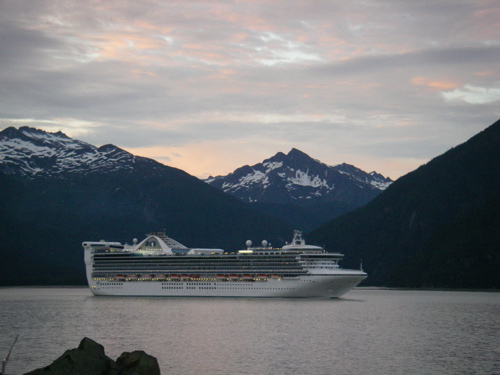“There’s a city floating by,” Aly comments, looking out the window. At 9:00 pm the sun, as high as late afternoon in the lower 48, lights up a massive white ship cruising south past the homestead. She’s not exaggerating. Ships like this one can hold 6,000 passengers. With the crew, staff, and entertainers needed to see to their every comfort, there must be at least several hundred more on board. That’s more people than you’ll find in the majority of Alaska’s towns and villages.
This ship has a spiral water slide above the outdoor pool, tennis courts, and a massive movie screen, possibly showing “coming attractions” scenes of Glacier Bay. I count twelve decks above the waterline. It’s a skyscraper by our standards, and it’s cruising past at more than 20 knots. The announcements blaring over the PA system echo against our ridge. Everywhere along the side facing us, cameras flash as tourists try to photograph Rainbow Glacier looming behind our peninsula. Most of them will end up with an overexposed edge of white railing, with a dark, unfocused blur of the view beyond.
From May to September, cruise ships like this one, and many far larger and smaller, pass back and forth in front of our homestead. After dark they’re lit so brightly that they will illuminate our bedroom in the wee hours of the morning. Their wakes wash our shores and sometimes disrupt our fishing. On calm days their exhaust hangs in the air like clouds.
At the height of the season, a parade of ships moves north in the early morning hours, to disgorge passengers at Skagway or Haines by the time the shops open. In the evening, they come back south. Their coming and going creates a rhythm that has become a part of our summers.

Two of this year’s ships. The one farther out is angling across Lynn Canal to pass close to the sea lion haul out at Gran Point (Photo: Mark Zeiger)
The pros and cons of cruise ship activity keep our community and most others in Southeast Alaska arguing throughout the year. We’re very ambivalent about the whole situation. Its affect on us is mixed. Having such large craft plying our waters is incongruous, sometimes annoying, occasionally even dangerous, but we also appreciate a glimpse of a lifestyle that is totally alien to our own. When they arrive in summer we’re happy to see them, and when they stop their runs in the autumn, we’re a bit sorry to see them go.

